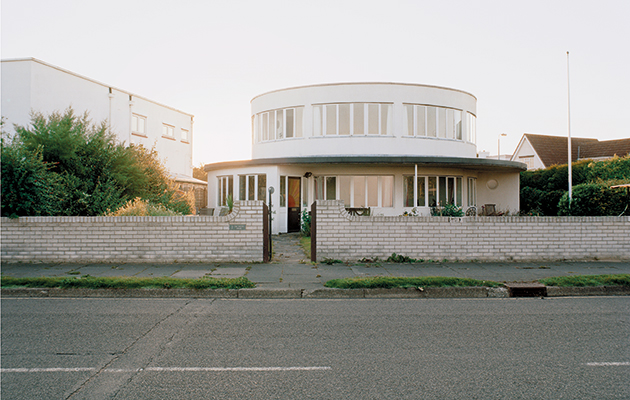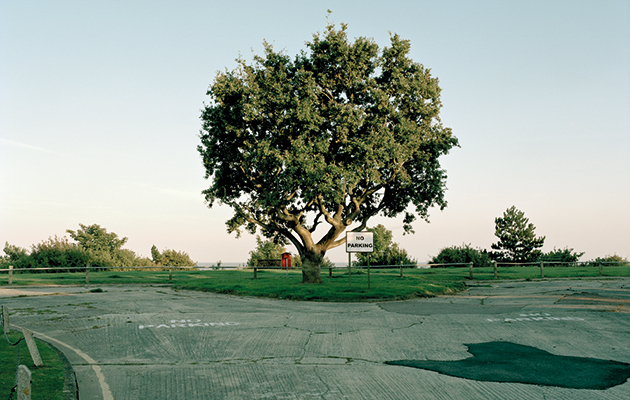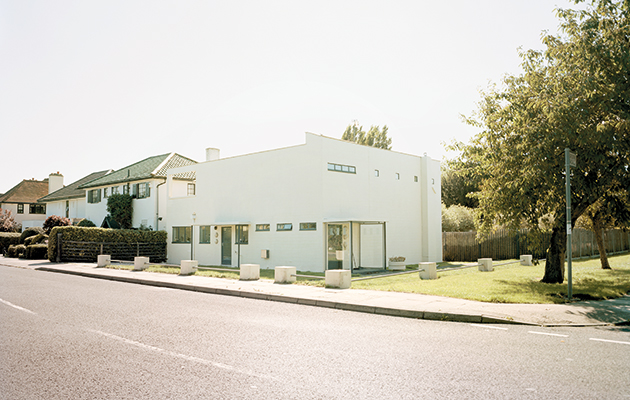|
|
||
|
Beyond the A13, the staid seaside towns and the flat, muddy fields of its heartland lies an alternative Essex – an unlikely hotbed of radical modernism. Experimental communities such as Silver End and Frinton Park Village were a future that never quite arrived, but they still offer a compelling vision of what rural architecture could yet become Ulting is a small village in Essex, tucked away down a winding lane lined with pink-plastered houses. There is a tiny but handsome brick schoolhouse and a church that overlooks a particularly serene stretch of the River Chelmer. Somewhere among all this, lurking in the undergrowth, is Richard Rogers’s first-ever solo building, a bright yellow steel-framed tribute to the Los Angeles Case Study Houses. The house was commissioned by Humphrey Spender, brother of poet Stephen, and photographer, painter, textile designer and all-round modernist polymath. Built in 1968, it consists of two rectangular sheds, one containing the house and the other Spender’s studio. Both have externally expressed steel portal frames in-filled with floor-to-ceiling single glazing or crinkly metal cladding. They look like a pair of miniature industrial buildings parked in a mature garden. |
Words Charles Holland
Photography Catherine Hyland
Above: Oliver Hill’s imposing Round House in Frinton on Sea (1935) |
|
|
||
|
Wolverton, 77 Boars Tye Road, Silver End, by Thomas Smith Tait (1928) |
||
|
Although he died in 2005, the studio is still full of Spender’s remarkably diverse output: paintings, prints, fabrics and found objects are scattered around, preserved as if he had just popped over to the house for a cup of tea. The house itself is wonderful, unrefurbished and almost completely original. The plan is a compact rectangle, neatly organised and extremely logical if you ignore the alarming structural details, which possibly work better under the Californian sun than an Essex winter. But the joy is in the visual connections to the garden and the vivid, practically psychedelic colour scheme. The JCB-yellow roof trusses are augmented by purple doors and striped curtains that run through a rainbow of shades of orange. Sadly the original bright red carpet has been replaced by a more subdued tone, but the interior still has the capacity to shock, its late 1960s grooviness sitting incongruously in the bucolic countryside. |
||
|
The Spender House, Ulting, Richard and Su Rogers (1968) |
||
|
I’ve come looking for this house for a number of reasons, some personal, others professional. I was brought up in Essex, in a very similar village just a few miles away. It is a landscape I know well, but not one I previously associated with avant-garde experiments like the Spender House. When I first came across its existence a couple of years ago, I experienced a jolt of recognition and shock, a moment when previously discrete aspects of my life collided. But Essex, it turns out, is a hotbed of modernist experimentation. My visit to the Spender House is part of a bigger journey, a road trip across the county in search of other outposts of modernism, fascinating examples of utopian settlements, factory villages and holiday estates. |
||
|
Frinton on Sea. Men are still banned from removing their shirts on the headland |
||
|
Silver End is about 20 minutes drive from Ulting and was built in the mid-1920s by the Crittall Windows company. Like the contemporaneous town of East Tilbury on the Thames Estuary, sponsored by Bata Shoes, it was planned as a village to house workers. Silver End included a library, department store and health clinic as well as a church and public gardens. Some of the housing was designed in an anonymous, neo-Georgian manner: plain-fronted rows of brick terraces, albeit with Crittall’s trademark steel-framed windows. But Francis Crittall, the factory owner, also commissioned Scottish architect Thomas Tait to design two streets of white-rendered art deco-inflected houses. Dotted here and there are larger, detached villas for factory managers, also by Tait. These are more elaborate essays in early modernism, not exactly revolutionary but still striking and ambitious buildings to come across in the muddy fields of rural Essex. |
||
|
1 Easton Way in Frinton, by Oliver Hill (1935–38) |
||
|
Silver End was an exercise in modern commercialism as much as philanthropy. The village advertised the product as well as housing the workers. Though the factory, which closed in 2006, has largely been demolished, the houses are still there and have settled happily into the landscape, acquiring the accoutrements of English domesticity along the way. Their gardens now include timber wishing-wells and plastic birdbaths. Some of them have been repainted in Essex-friendly pastel shades. The sharpness of the flat roofs and triangular windows may have dulled a little over time but they have weathered well. There is another outpost of Essex Moderne in the seaside town of Frinton on Sea, a fiercely conservative place that until relatively recently resisted the vulgarity of either a pub or a fish-and-chip shop. Men are still banned from removing their shirts on the headland and there is a strong air of retired colonel about the place. Frinton boasts a golf course, a spectacular number of teashops and wide avenues lined with big, baggy Edwardian houses, including one bona-fide masterpiece in Charles Voysey’s The Homestead. |
||
|
Frinton on Sea |
||
|
None of this prepares you for Frinton Park Village, the modernist estate planned on the edge of town by Oliver Hill in the 1920s. Hill was an interesting character, something of a party animal and an early proselytiser for modernism, along with the benefits of sunbathing, sea swimming and naturism. He designed the spectacular Morecambe Bay Hotel – recently refurbished by Urban Splash – and a delightful pub on the Isle of Thanet called The Prospect Inn – but Frinton Park Village was his most ambitious pre-war project. It wasn’t a success, partly because the flat-roofed, art deco houses designed by Hill along with others, proved hard to sell. Mortgage lenders were suspicious of their innovative construction and buyers were put off by the austere aesthetics. Only a handful of genuinely modernist designs were completed and these are now pepper-potted between later, more traditional-looking fare. Palm trees suggest a sense of continental glamour and the houses themselves, with their angular balconies and ship-like handrails, appear considerably more sophisticated than what came after. |
||
|
New-build modernism in Frinton |
||
|
You can read the recent history of British housing here in the bizarre juxtapositions of decorated bungalows and abstract white cubes. Rising-sun motifs recur in the railings, gates and coloured-glass windows of the Oliver Hill houses, creating a particularly English kind of Metroland modernism. The most striking house is Hill’s own design. Built as a show home, the Round House contains a floor mosaic depicting the plan for the whole estate. It is like a diorama depicting a future that never quite arrived. The concrete roads of the estate are cracked and some of the houses, like those at Silver End, languish slightly sadly in the undergrowth. Partially hidden by a thicket of trees are the remains of Frinton Park Court, the estate’s planned shopping centre. It never quite got off the ground and in recent years was used as a Masonic hall. It’s now in a badly dilapidated state and due to be demolished. Despite this, there is a sense that the houses of Frinton Park Estate are being reappraised and, inevitably, bought up by design enthusiasts. Some have been recently refurbished and there is even a recent new arrival that attempts, somewhat crudely, to ape the style of the early houses. |
||
|
10 Easton Way, by RA Duncan (1935) nestles behind more typical Essex housing |
||
|
Heading back to London, we have another stop. Romford is no one’s idea of utopia, but even here there is experimental architecture to be found. Romford Garden Suburb was the product of two architectural competitions intended to drum up buyers for the newly planned suburb. The Liberal MP and landowner Sir Herbert Raphael organised an international exhibition of homes here in 1910, commissioning 140 designs, including a pair of cottages by Baillie Scott and a wonderfully taut detached house by Parker and Unwin. A second phase was commissioned in 1934 and included 64 Heath Drive, a still-startling exercise in white-walled abstraction designed by Francis Skinner of Berthold Lubetkin’s Tecton Group. Today, Romford Garden Suburb is obviously well-off and smart. There are Jags and Rollers in the driveways and an air of comfortable, Essex-made-good affluence pervades the place. The earlier Arts and Crafts-influenced houses lend themselves well to current aspirations, with their exaggerated chimneys, richly decorative brickwork and leaded-light windows. Some of them are a little nuts, all of them are over-ripe but they look comfortably and traditionally like home. The Tecton-designed house has none of the regular accoutrements of upward mobility: instead it sits inscrutable and aloof like a soberly dressed aesthete appalled by its more ostentatious neighbours.
64 Heath Drive, Gidea Park, by Skinner & Tecton (1934)
The current owner of the Grade II-listed 64 Heath Drive by Skinner & Tecton (1934) Most places in England can boast some interesting early modernist architecture: the odd example of an innovative factory or a one-off house. But Essex is interesting because the examples are both more plentiful and more ambitious. Frinton Park Estate is the largest collection of modernist houses in the country. Along with Silver End and East Tilbury, these were rivals to estates like Pessac in France or the Deutscher Werkbund experiments in Germany. They belie the reputation of England as an essentially conservative country resistant to modernism. What can we learn from them today? Well, partly it is that done well and designed intelligently, architecture can add to rather than detract from the landscape. Radicalism and ruralism are not always uneasy bedfellows. The English countryside is already home to weird and wonderful social and architectural experiments: philanthropic workers’ villages, utopian communes and self-build “plotland” communities. These planned settlements give the lie to the idea that villages are always organic forms that have developed over long periods of time. |
||
|
64 Heath Drive is “a startling exercise in white-walled abstraction” |
||
|
The 1920s and 30s were a productive period for such experiments. Modernist convictions combined with industrialisation and pre-welfare state philanthropy to create all sorts of experimental communities. There are examples of ambitious new villages designed in the second half of the 20th century – New Ash Green in Kent for example – but mostly the emphasis shifted to inner-city rebuilding and the new towns. For all its visual rhetoric of mass-production, the Spender House is not in itself an ambitious social experiment. Its late 1960s take on the industrial aesthetic links it conceptually rather than programmatically to somewhere like Silver End. But it still points to a more radical idea of what rural architecture could be. Away from the stifling social conservatism and commercial cynicism of contemporary speculative housing is a future that is still open to us. The Spender House resonates with its utopian antecedents. It is a techno-hymn to arcadianism, appropriately enough set within an Edenic orchard. Wandering around its beautiful garden, flowers curling around the tension wires that brace the structure, an alternative history of post-war housing comes to mind. Tantalisingly, it still offers a new start. This article first appeared in Icon 149 – click here to read more |
||
 |
||





























